Influence of Socio-Cultural Attributes on Stigmatizing Public Transport in Saudi Arabia
Abstract
1. Introduction
2. Literature Review
2.1. Stigma and Public Transportation
2.2. Fuzzy Inference System (FIS) and Public Transportation
2.3. Development of Equity and Gender Equality for the Improvement of Public Transport
3. Materials and Methods
3.1. Description of the Study Area
3.2. Preliminary Processing of Data from Online Survey
3.3. Modeling “Stigma” Using Fuzzy Inference System (FIS) and Expert Opinions
3.3.1. Stigma Fuzzy Model 1
3.3.2. Stigma Fuzzy Model 2
4. Study Results
4.1. Reflection: Non-User Perceptions and User Experience
4.2. Numerical Evaluation of the Results Using Fuzzy Models
Sensitivity Analysis
5. Discussion and Conclusions
- Guarantee full and effective gender participation and equal leadership opportunities at all decision-making levels in the political, economic and public life spheres [102]
- Plan cities tailored to each inhabitant by promoting the safety of places with continuous control through surveillance and video cameras and greater lighting [103]
- Plan transport services specifically designed for gender needs, paying particular attention to unsystematic travel and the design of vehicles and infrastructures [104]
- Promote the development of multimodal mobility and MaaS digital platforms by emphasizing the importance of complementary transport services such as DRT or shared mobility services in transport areas with low demand [105].
- Design mobility and land uses with attention to gender needs. Planning a city of “short distances” by locating public transport stops close enough so that the movements to reach public transport can be made on foot, create routes of safe pedestrian and cycle paths, and revitalize the social and residential dimension of the road network [106,107,108].
Author Contributions
Funding
Institutional Review Board Statement
Informed Consent Statement
Data Availability Statement
Acknowledgments
Conflicts of Interest
Appendix A
| Abbreviation | Question | Impact | |
|---|---|---|---|
| Q1 | Convenient Bus Stop | Is the environment of SAPTCO bus stops convenient? | Reverse |
| Q2 | Timing | Are you satisfied with the timing of SAPTCO buses? | Reverse |
| Q3 | Fare | Are you satisfied with the current SAPTCO bus fare system? | Reverse |
| Q4 | Safe | Please rate the degree to which you agree with the statement: “During my travel in SAPTCO buses, I feel Safe” | Reverse |
| Q5 | Privacy | Please rate the degree to which you agree with the statement: “During my travel in SAPTCO buses, my privacy being kept” | Reverse |
| Q6 | Humiliation | Please rate the degree to which you agree with the statement: “During my travel in SAPTCO buses, I feel humiliated” | Direct |
| Q7 | Overall Service | Please rate the overall level of service offered by SAPTCO buses | Reverse |
| Q8 | Children Transportation | Mode of transportation your school-age children use to go to school is SAPTCO | Reverse |
| Q9 | BRT as an Alternative | If your children currently use private automobiles, will you ask them to use an alternative mode of transportation (particularly, BRT) in case that it is introduced? | Reverse |
| Q10 | Female Favorable | If the bus environment becomes more favorable to females, will you take buses? | Direct |
| Q11 | Female Privacy | If the bus environment provides higher privacy, will you take buses? | Direct |
| Q12 | Family Comfort | How did you feel while traveling with your family? (Comfortable?/Uncomfortable) | Reverse |
| Q13 | Family Safe | How did you feel while traveling with your family? (Safe?/Unsafe) | Reverse |
| Q14 | Family Privacy | How did you feel while traveling with your family? (Privacy respected?/violated) | Reverse |
| Q15 | Family Grace | How did you feel while traveling with your family? (Family was graced?/disgraced) | Reverse |
| Q16 | Commute to Office | How SAPTCO is convenient for Commuting to school/office? | Reverse |
| Q17 | Travel to Stores | How SAPTCO is convenient for Going to shopping centers/stores? school/office | Reverse |
| Q18 | Visiting Leisure Venues | How SAPTCO is convenient for Visiting leisure venues? | Reverse |
References
- Crocker, J.; Major, B.; Steele, C. Socialstigma. In Handbook of Social Psychology; Fiske, S., Gilbert, D., Lindzey, G., Eds.; McGraw-Hill: Boston, MA, USA, 1998; Volume 2, pp. 504–553. [Google Scholar]
- Major, B.; O’Brien, L. The social psychology of stigma. Annu. Rev. Psychol. 2005, 56, 393–421. [Google Scholar] [CrossRef] [PubMed]
- Bertrand, M.; Chugh, D.; Mullainathan, S. Implicit Discrimination. Am. Econ. Rev. Pap. Proc. 2005, 95, 94–98. [Google Scholar] [CrossRef]
- Beaman, L.; Chattopadhyay, R.; Duflo, E.; Pande, R.; Topalova, P. Powerful Women: Does Exposure Reduce Prejudice. Q. J. Econ. 2009, 124, 1497–1540. [Google Scholar] [CrossRef]
- Corno, L.; Ferrara, E.L.; Burns, J. Interaction, stereotypes and performance. Evidence from South Africa. In Institute for Fiscal Studies Working Paper W19/03; Institute for Fiscal Studies: London, UK, 2018. [Google Scholar]
- Kondylis, F.; Legoviniy, A.; Vybornyz, K.; Zwagery, A.; Andradey, L. Demand for Safe Spaces—Avoiding Harassment and Stigma. 2020. Available online: https://openknowledge.worldbank.org/handle/10986/33853 (accessed on 2 June 2020).
- Schweitzer, L. Planning and Social Media: A Case Study of Public Transit and Stigma on Twitter. J. Am. Plan. Assoc. 2014, 80, 218–238. [Google Scholar] [CrossRef]
- Aguilar, A.; Gutierrez, E.; Villagran, P.S. Benefits and Unintended Consequences of Gender Segregation in Public Transportation: Evidence from Mexico City’s Subway System. EDCC 2018, 69. [Google Scholar] [CrossRef]
- Campisi, T.; Basbas, S.; Al-Rashid, M.A.; Tesoriere, G.; Georgiadis, G. A region-wide survey on emotional and psychological impacts of COVID-19 on public transport choices in Sicily, Italy. Trans. Transp. Sci. 2021, 2, 1–10. [Google Scholar] [CrossRef]
- Al-Rashid, M.A.; Goh, H.C.; Harumain, Y.A.S.; Ali, Z.; Campisi, T.; Mahmood, T. Psycho-social barriers of public transport use and social exclusion among older adults: Empirical evidence from Lahore, Pakistan. Int. J. Environ. Res. Public Health 2021, 18, 185. [Google Scholar] [CrossRef]
- Nahiduzzaman, K.M.; Lai, S.K. What does the Global Pandemic COVID-19 Teach Us? Some Reflections. J. Urban Manag. 2020, 9, 261. [Google Scholar] [CrossRef]
- Nahiduzzaman, K.M. COVID-19 and Change Dynamics in the Transformational Cities. J. Urban Manag. 2021, 10, 95–96. [Google Scholar] [CrossRef]
- General Authority for Statistics. Tenth Development Plan, Saudi Arabia. 2015. Available online: https://www.stats.gov.sa/en/page/72 (accessed on 16 November 2015).
- SAPTCO. Available online: http://www.saptco.com.sa/mainsite/home.aspx (accessed on 1 May 2014).
- Salama, K.F.; Alhajri, R.F.; Al-Anazi, A.A. Assessment of air quality in bus terminal stations in Eastern Province, Kingdom of Saudi Arabia. Int. J. Community Med. Public Health 2017, 4, 1413. [Google Scholar] [CrossRef]
- Venter, C.; Jennings, G.; Hidalgo, D.; Valderrama Pineda, A.F. The equity impacts of bus rapid transit: A review of the evidence and implications for sustainable transport. Int. J. Sustain. Transp. 2018, 12, 140–152. [Google Scholar] [CrossRef]
- Al-Fouzan, S.A. Using Car Parking Requirements to Promote Sustainable Transport Development in the Kingdom of Saudi Arabia. Cities 2012, 29, 201–211. [Google Scholar] [CrossRef]
- Alotaibi, O.; Potoglou, D. Perspectives of travel strategies in light of the new metro and bus networks in Riyadh City, Saudi Arabia. Transp. Plan. Technol. 2017, 40, 4–27. [Google Scholar] [CrossRef]
- Yang, L.; Chau, K.W.; Chu, X. Accessibility-based premiums and proximity-induced discounts stemming from bus rapid transit in China: Empirical evidence and policy implications. Sustain. Cities Soc. 2019, 48, 101561. [Google Scholar] [CrossRef]
- Goffman, E. Stigma: Notes on the Management of Spoiled Identity; Prentice Hall: New York, NY, USA, 1963. [Google Scholar]
- Hass-Klau, C. Accessibility in Metropolitan Regions: Why are the rich now moving close to public transportation services? In Proceedings of the Planning and Sustainable Development of Metropolitan Capitals and Regions Conference, Madrid, Spain, 2006. [Google Scholar]
- Assi, K.J.; Nahiduzzaman, K.M.; Ratrout, N.T.; Aldosary, A.S. Mode choice behavior of high school goers: Evaluating logistic regression and MLP neural networks. Case Stud. Transp. Policy 2018, 6, 225–230. [Google Scholar] [CrossRef]
- Assi, K.J.; Shafiullah, M.; Nahiduzzaman, K.M.; Mansoor, U. Travel-to-school mode choice modelling employing artificial intelligence techniques: A comparative study. Sustainability 2019, 11, 4484. [Google Scholar] [CrossRef]
- Rahman, M.T.; Nahiduzzaman, K.M. Examining the walking accessibility, willingness, and travel conditions of residents in Saudi cities. Int. J. Environ. Res. Public Health 2019, 16, 545. [Google Scholar] [CrossRef]
- Al-Rashid, M.A.; Nahiduzzaman, K.M.; Ahmed, S.; Campisi, T.; Akgün, N. Gender-Responsive Public Transportation in the Dammam Metropolitan Region, Saudi Arabia. Sustainability 2020, 12, 9068. [Google Scholar] [CrossRef]
- Garling, T. Changes of private car use in response to travel demand management. In Traffic and Transportation Psychology. Theory and Application. Proceedings of the ICTTP 2004; Underwood, G., Ed.; Elsevier: Oxford, UK, 2005. [Google Scholar]
- Steg, L.; Tertoolen, G. Affective Motives for Car Use. In Transport Policy, Planning and Practice; PTRC: London, UK, 1999; pp. 13–27. [Google Scholar]
- Steg, L.; Gatersleben, B. A social dilemma analysis of car use: A comparison between UK and the Netherlands. In Proceedings of the Second International Conference on Traffic and Transport Psychology, Bern, Switzerland; 2000. [Google Scholar]
- Abrahamse, W.; Steg, L.; Gifford, R.; Vlek, C. Psychological factors influencing car use for commuting. In Proceedings of the Third International Conference on Traffic & Transport Psychology, Nottingham, UK, 5–9 September 2004. [Google Scholar]
- Gatersleben, B. Affective, social and instrumental aspects of the commute to work: Comparing perceptions of drivers, public transport users, walkers and cyclists. In Proceedings of the Third International Conference on Traffic & Transport Psychology, Nottingham, UK, 5–9 September 2004. [Google Scholar]
- Mann, E.; Abraham, S.C.S. The role of affect in UK commuters’ travel mode choices: An interpretative phenomenological analysis. Br. J. Psychol. 2006, 97, 155–176. [Google Scholar] [CrossRef]
- Steg, L.; Geurs, K.; Ras, M. The effects of motivational factors on car use: A multidisciplinary modelling approach. Transp. Res. Part A 2001, 35, 789–806. [Google Scholar] [CrossRef]
- Steg, L.; Geurs, K.; Ras, M. Motives in transport models: Can they be ignored? In Travel Behaviour Research: The Leading Edge; Hensher, D., Ed.; Pergamon Press: Amsterdam, The Netherlands, 2001. [Google Scholar]
- Steg, L.; Vlek, C.; Slotegraaf, A. Instrumental-reasoned and symbolic-affective motives for using a motor car. Transp. Res. Part F 2001, 4, 151–169. [Google Scholar] [CrossRef]
- Moslem, S.; Campisi, T.; Szmelter-Jarosz, A.; Duleba, S.; Nahiduzzaman, K.M.; Tesoriere, G. Best-Worst Method for Modelling Mobility Choice after COVID-19: Evidence from Italy. Sustainability 2020, 12, 6824. [Google Scholar] [CrossRef]
- Steg, L. Car Use: Lust and must. Instrumental, symbolic and affective motives for car use. Transp. Res. Part A 2005, 39, 147–162. [Google Scholar] [CrossRef]
- Beirao, G.; Cabral, J.S. Understanding attitudes towards public transport and private car: A qualitative study. Transp. Policy 2007, 14, 478–489. [Google Scholar] [CrossRef]
- Iseki, H.; Taylor, B.D. Style versus service? Analysis of user perceptions of transit stops and stations in Los Angeles. In Proceedings of the 87th Annual Meeting of the TRB, Washington, DC, USA, 13–17 January 2008. [Google Scholar]
- Tyrinopoulos, Y.; Antoniou, C. Public transit user satisfaction: Variability and policy implications. Transp. Policy 2008, 15, 260–272. [Google Scholar] [CrossRef]
- Joewono, T.B.; Kubota, H. User perception of private paratransit operation in Indonesia. J. Public Transp. 10 2007, 4, 99–118. [Google Scholar] [CrossRef]
- Stuart, K.R.; Mednick, M.; Bockman, J. Structural equation model of customer satisfaction for the New York City subway system. Transp. Res. Rec. 2000, 1735, 133–137. [Google Scholar] [CrossRef]
- Eboli, L.; Mazzulla, G. Service quality attributes affecting customer satisfaction for bus transit. J. Public Transp. 2007, 10, 21–34. [Google Scholar] [CrossRef]
- Nurul-Habib, K.M.; Kattan, L.; Islaam, T. Why do the people use transit? A model for explanation of personal attitude towards transit service quality. In Proceedings of the 88th Annual Meeting of the TRB, Washington, DC, USA, 11–15 January 2009. [Google Scholar]
- Hess, A. Race, Class, and the Stigma of Riding the Bus in America—Amanda Hess—The Atlantic Cities. 2012. Available online: http://www.theatlanticcities.com/commute/2012/07/race-class-and-stigma-riding-bus-america/2510/ (accessed on 1 May 2014).
- Bromley, D.W.; Buehler, R. How can the stigma of public transport as the ‘poor man’s vehicle’ be overcome to enhance sustainability and climate change mitigation? Nat. Resour. Forum 2011, 34, 327–331. [Google Scholar] [CrossRef][Green Version]
- Walker, J. Why We Should Stop Talking About “Bus Stigma”. 2012. Available online: http://www.theatlanticcities.com/commute/2012/07/why-we-should-stop-talking-about-bus-stigma/2601/ (accessed on 1 May 2014).
- Narefsky, K. Revisiting Bus Stigma. 2012. Available online: https://www.jacobinmag.com/2012/08/bus-stigma/ (accessed on 1 May 2014).
- Webber, R. The Bus Stigma: Why It Exists, and Should We Care? 2012. Available online: http://www.ssti.us/2012/07/the-bus-stigma-why-it-exists-and-should-we-care/ (accessed on 1 May 2014).
- Keddy, K. Resistance to Using Public Transportation: Stigma, Classism, and Negative Perceptions, 2010. Available online: http://iaps.scix.net/cgi-bin/works/Show?iaps_21_2010_230_2 (accessed on 2 December 2010).
- Tran, H.A.; Schlyter, A. Gender and class in urban transport: The cases of Xian and Hanoi. Environ. Urban. 2010, 22, 139–155. [Google Scholar] [CrossRef]
- Kumar, A.; Zimmerman, S.; Agarwal, O.P. International Experience in Bus Rapid Transit Implementation: Synthesis of Lessons Learned from Lagos, Johannesburg, Jakarta, Delhi, and Ahmedabad; The World Bank: Washington, DC, USA, 2012. [Google Scholar]
- Cuenot, F.; Fulton, L.; Staub, J. The prospect for modal shifts in passenger transport worldwide and impacts on energy use and CO2. Energy Policy 2012, 41, 98–106. [Google Scholar] [CrossRef]
- Linovski, O.; Baker, D.M.; Manaugh, K. Equity in practice? Evaluations of equity in planning for bus rapid transit. Transp. Res. Part A Policy Pract. 2018, 113, 75–87. [Google Scholar] [CrossRef]
- Asgharzadeh, M.; Shafahi, Y. Real-time bus-holding control strategy to reduce passenger waiting time. Transp. Res. Rec. 2017, 2647, 9–16. [Google Scholar] [CrossRef]
- Bunker, J.M. High volume bus stop upstream average waiting time for working capacity and quality of service. Public Transp. 2018, 10, 311–333. [Google Scholar] [CrossRef]
- Gómez-Ortiz, V.; Cendales, B.; Useche, S.; Bocarejo, J.P. Relationships of working conditions, health problems and vehicle accidents in bus rapid transit (BRT) drivers. Am. J. Ind. Med. 2018, 61, 336–343. [Google Scholar] [CrossRef]
- Bocarejo, J.P.; Velasquez, J.M.; Díaz, C.A.; Tafur, L.E. Impact of bus rapid transit systems on road safety: Lessons from Bogotá, Colombia. Transp. Res. Rec. 2012, 2317, 1–7. [Google Scholar] [CrossRef]
- Figueroa, M.J.; Fulton, L.; Tiwari, G. Avoiding, transforming, transitioning: Pathways to sustainable low carbon passenger transport in developing countries. Curr. Opin. Environ. Sustain. 2013, 5, 184–190. [Google Scholar] [CrossRef]
- Currie, G. Bus Rapid Transit in Australasia: Performance, Lessons Learned and Futures. Public Transp. BRT Spec. 2006, 9, 1. [Google Scholar] [CrossRef]
- Mnglor, L.M. The Role of Bus Rapid Transit in Improving Public Transport Levels of Service, Particularly for the Urban Poor Users of Public Transport a Case of Cape Town; University of Cape Town: Cape Town, South Africa, 2011. [Google Scholar]
- Campisi, T.; Tesoriere, G.; Canale, A. Microsimulation approach for BRT system: The case study of urban turbo roundabout. In AIP Conference Proceedings; AIP Publishing LLC: Melville, NY, USA, 2017; Volume 1906, p. 190005. [Google Scholar]
- Nadeem, M.; Azam, M.; Asim, M.; Al-Rashid, M.A.; Puan, O.C.; Campisi, T. Does Bus Rapid Transit System (BRTS) Meet the Citizens’ Mobility Needs? Evaluating Performance for the Case of Multan, Pakistan. Sustainability 2021, 13, 7314. [Google Scholar] [CrossRef]
- Yang, L.; Chu, X.; Gou, Z.; Yang, H.; Lu, Y.; Huang, W. Accessibility and proximity effects of bus rapid transit on housing prices: Heterogeneity across price quantiles and space. J. Transp. Geogr. 2020, 88, 102850. [Google Scholar] [CrossRef]
- Singer, M.E. Restructuring public transport through bus rapid transit: An international and interdisciplinary perspective. Transp. Rev. 2019, 9, 420–421. [Google Scholar] [CrossRef]
- Torrisi, V.; Campisi, T.; Inturri, G.; Ignaccolo, M.; Tesoriere, G. Continue to share? An overview on Italian travel behavior before and after the COVID-19 lockdown. In AIP Conference Proceedings; AIP Publishing LLC: Melville, NY, USA, 2021; Volume 2343, p. 090010. [Google Scholar]
- Campisi, T.; Canale, A.; Ticali, D.; Tesoriere, G. Innovative solutions for sustainable mobility in areas of weak demand. Some factors influencing the implementation of the DRT system in Enna (Italy). In AIP Conference Proceedings; AIP Publishing LLC: Melville, NY, USA, 2021. [Google Scholar]
- Ahangari, S.; Chavis, C.; Jeihani, M. Public Transit Ridership Analysis during the COVID-19 Pandemic. medRxiv 2020. [Google Scholar] [CrossRef]
- Abdullah, M.; Ali, N.; Shah, S.A.H.; Javid, M.A.; Campisi, T. Service Quality Assessment of App-Based Demand-Responsive Public Transit Services in Lahore, Pakistan. Appl. Sci. 2021, 11, 1911. [Google Scholar] [CrossRef]
- Lubiano, M.A.; de Sáa, S.D.L.R.; Montenegro, M.; Sinova, B.; Gil, M.Á. Descriptive analysis of responses to items in questionnaires. Why not using a fuzzy rating scale? Inf. Sci. 2016, 360, 131–148. [Google Scholar] [CrossRef]
- Lin, L.; Lee, H.M. Fuzzy assessment method on sampling survey analysis. Expert Syst. Appl. 2009, 36, 5955–5961. [Google Scholar] [CrossRef]
- Kontogianni, A.; Tourkolias, C.; Papageorgiou, E.I. Revealing market adaptation to a low carbon transport economy: Tales of hydrogen futures as perceived by fuzzy cognitive mapping. Int. J. Hydrog. Energy 2013, 38, 709–722. [Google Scholar] [CrossRef]
- Ngan, S.C. Decision making with extended fuzzy linguistic computing, with applications to new product development and survey analysis. Expert Syst. Appl. 2011, 38, 14052–14059. [Google Scholar] [CrossRef]
- Nozari, M.A.; Ghadikolaei, A.S.; Govindan, K.; Akbari, V. Analysis of the sharing economy effect on sustainability in the transportation sector using fuzzy cognitive mapping. J. Clean. Prod. 2021, 311, 127331. [Google Scholar] [CrossRef]
- Szarata, A. Public transport induced demand estimation with application of Fuzzy Inference System. In 2017 4th International Conference on Transportation Information and Safety (ICTIS); IEEE: Piscataway, NJ, USA, 2017; pp. 1105–1110. [Google Scholar]
- Amini, M.; Hatwagner, M.F.; Mikulai, G.C.; Koczy, L.T. An intelligent traffic congestion detection approach based on fuzzy inference system. In 2021 IEEE 15th International Symposium on Applied Computational Intelligence and Informatics (SACI); IEEE: Piscataway, NJ, USA, 2021; pp. 97–104. [Google Scholar]
- Ortega, L.C.; Otero, L.D.; Otero, C. Fuzzy Inference System Framework to Prioritize the Deployment of Resources in Low Visibility Traffic Conditions; IEEE: Piscataway, NJ, USA, 2019; Volume 7, pp. 174368–174379. [Google Scholar]
- Dunckel Graglia, A. Finding mobility: Women negotiating fear and violence in Mexico City’s public transit system. Gend. Place Cult. 2016, 23, 624–640. [Google Scholar] [CrossRef]
- Korn, J. Riding Scared: Sexual Violence and Women’s Mobility on Public Transportation in Santiago, Chile, 2018. Available online: https://repository.upenn.edu/senior_seminar/24/ (accessed on 25 May 2021).
- Guzman, L.A.; Oviedo, D.; Rivera, C. Assessing equity in transport accessibility to work and study: The Bogotá region. J. Transp. Geogr. 2017, 58, 236–246. [Google Scholar] [CrossRef]
- Lecompte, M.C.; Pablo, B.S.J. Transport systems and their impact con gender equity. Transp. Res. Procedia 2017, 25, 4245–4257. [Google Scholar] [CrossRef]
- Alonso, F.; Useche, S.A.; Faus, M.; Esteban, C. Does urban security modulate transportation choices and travel behavior of citizens? A national study in the Dominican Republic. Front. Sustain. Cities 2020, 2, 42. [Google Scholar] [CrossRef]
- Esquivel, V. Power and the Sustainable Development Goals: A feminist analysis. Gend. Dev. 2016, 24, 9–23. [Google Scholar] [CrossRef]
- Yin, R. Case Study Research and Applications: Design and Methods; SAGE Publications, Inc.: Thousand Oaks, CA, USA, 2018. [Google Scholar]
- Ministry of Transport. The Public Transport Authority, 2020. Available online: https://www.mot.gov.sa/en/TransportSystem/PublicTransport/Pages/default.aspx (accessed on 2 June 2020).
- Ministry of Transport. National Transportation Strategy, 2015. Available online: https://mot.gov.sa/ar/AboutUs/TKingdom/Documents/Final%20Report%20English%20New.pdf (accessed on 1 June 2021).
- Riyadh Economic Forum. Regional and Global Transport Hub: A Public-Private Partnership Opportunity, 2005. Available online: https://riyadhef.com/wp-content/uploads/2021/03/2005_02_03.pdf (accessed on 2 June 2021).
- Campisi, T.; Akgün, N.; Ticali, D.; Tesoriere, G. Exploring Public Opinion on Personal Mobility Vehicle Use: A Case Study in Palermo, Italy. Sustainability 2020, 12, 5460. [Google Scholar] [CrossRef]
- Chen, Y.; Frei, A.; Mahmassani, H.S. From personal attitudes to public opinion: Information diffusion in social networks toward sustainable transportation. Transp. Res. Rec. 2014, 2430, 28–37. [Google Scholar] [CrossRef]
- Ramos, S.; Vicente, P.; Passos, A.M.; Costa, P.; Reis, E. Perceptions of the public transport service as a barrier to the adoption of public transport: A qualitative study. Soc. Sci. 2019, 8, 150. [Google Scholar] [CrossRef]
- Azimirad, E.; Pariz, N.; Sistani, M.B.N. A novel fuzzy model and control of single intersection at urban traffic network. IEEE Syst. J. 2010, 4, 107–111. [Google Scholar] [CrossRef]
- Rutkowski, L. Fuzzy Inference Systems. In Flexible Neuro-Fuzzy Systems. The International Series in Engineering and Computer Science, 771; Springer: Boston, MA, USA, 2004. [Google Scholar]
- Zhang, G.; Li, H. An Efficient Configuration for Probabilistic Fuzzy Logic System. IEEE Trans. Fuzzy Syst. 2012, 20, 898–909. [Google Scholar] [CrossRef]
- Quek, C.; Pasquier, M.M.; Lim, B.L.B. POP-TRAFFIC: A novel fuzzy neural approach to road traffic analysis and prediction, IEEE Trans. Intell. Transp. Syst. 2006, 7, 133–146. [Google Scholar] [CrossRef]
- Steg, L. Instrumental, social and affective values of car use. In Proceeding of the Third International Conference on Traffic & Transport Psychology, Nottingham, UK, 5–9 September 2004. [Google Scholar]
- Tertoolen, G.; Van Kreveld, D.; Verstraten, B. Psychological resistance against attempts to reduce private car use. Transp. Res. Part A Policy Pract. 1998, 32, 171–181. [Google Scholar] [CrossRef]
- Steg, L.; Uneken, E. Car use: Lust and must. In Traffic and Transport Psychology: ICTTP 2000 Proceedings; Rothengatter, J., Huguenin, D., Eds.; Pergamon: Oxford, UK, 2002. [Google Scholar]
- Bus Partnership Forum. Understanding Customer Needs, 2003. Available online: https://publications.parliament.uk/pa/cm200203/cmhansrd/vo031021/text/31021w01.htm (accessed on 16 April 2020).
- Hensher, D. Future bus transport contracts under a mobility as a service (MaaS) regime in the digital age: Are they likely to change? Transp. Res. Part A Policy Pract. 2017, 98, 86–96. [Google Scholar] [CrossRef]
- Topal, A. Economic reforms and women’s empowerment in Saudi Arabia. Women’s Stud. Int. Forum 2019, 76. [Google Scholar] [CrossRef]
- Kotler, P.; Roberto, N.; Lee, N. Social Marketing: Improving the Quality of Life; Sage Publications: California, CA, USA, 2002. [Google Scholar]
- Dyer, M.; Weng, M.-H.; Wu, S.; Garcia Ferrari, T.; Dyer, R. Urban narrative: Computational linguistic interpretation of large format public participation for urban infrastructure. Urban Plan. 2020, 5, 20–32. [Google Scholar] [CrossRef]
- Campisi, T.; Basbas, S.; Tesoriere, G.; Trouva, M.; Papas, T.; Mrak, I. How to Create Walking Friendly Cities. A Multi-Criteria Analysis of the Central Open Market Area of Rijeka. Sustainability 2020, 12, 9470. [Google Scholar] [CrossRef]
- Taylor, E. Lights, camera, redaction… Police body-worn cameras; autonomy, discretion and accountability. Surveill. Soc. 2016, 14, 128–132. [Google Scholar] [CrossRef]
- Pirra, M.; Kalakou, S.; Carboni, A.; Costa, M.; Diana, M.; Lynce, A.R. A preliminary analysis on gender aspects in transport systems and mobility services: Presentation of a survey design. Sustainability 2021, 13, 2676. [Google Scholar] [CrossRef]
- Campisi, T.; Garau, C.; Acampa, G.; Maltinti, F.; Canale, A.; Coni, M. Developing Flexible Mobility On-Demand in the Era of Mobility as a Service: An Overview of the Italian Context Before and After Pandemic. In International Conference on Computational Science and Its Applications; Springer: Cham, Switzerland, 2021; pp. 323–338. [Google Scholar]
- Campisi, T.; Nahiduzzaman, K.M.; Akgün, N.; Ticali, D.; Tesoriere, G. Gender equality on developing transport system in sicily: A consideration on regional scale. In AIP Conference Proceedings; AIP Publishing LLC: Melville, NY, USA, 2021; Volume 2343, p. 090003. [Google Scholar]
- Viswanath, K.; Mehrotra, S.T. ‘Shall we go out?’ Women’s safety in public spaces in Delhi. Econ. Political Wkly. 2007, 42, 1542–1548. [Google Scholar]
- Kenyon, S.; Lyons, G.; Rafferty, J. Transport and social exclusion: Investigating the possibility of promoting inclusion through virtual mobility. J. Transp. Geogr. 2002, 10, 207–219. [Google Scholar] [CrossRef]

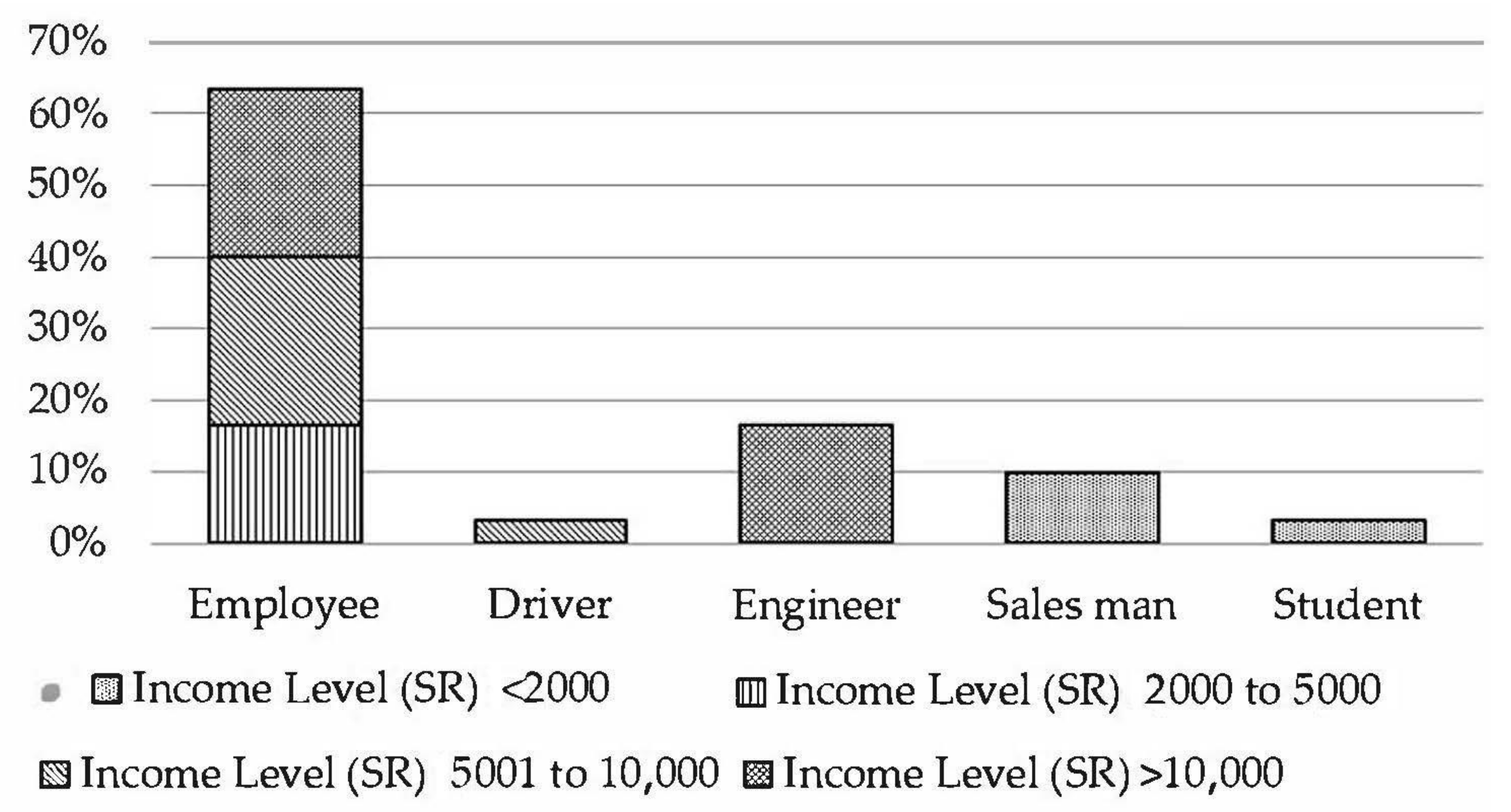
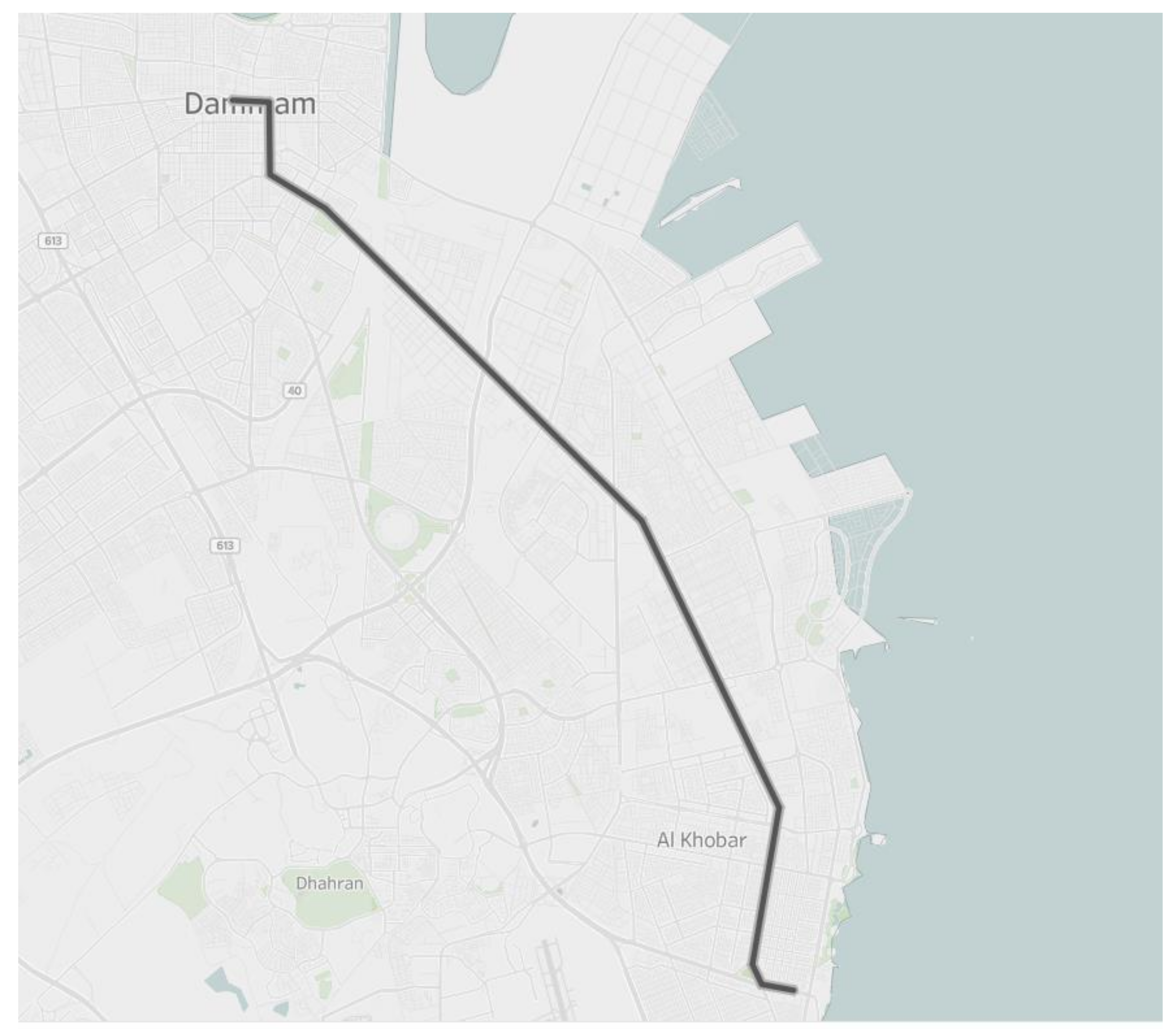
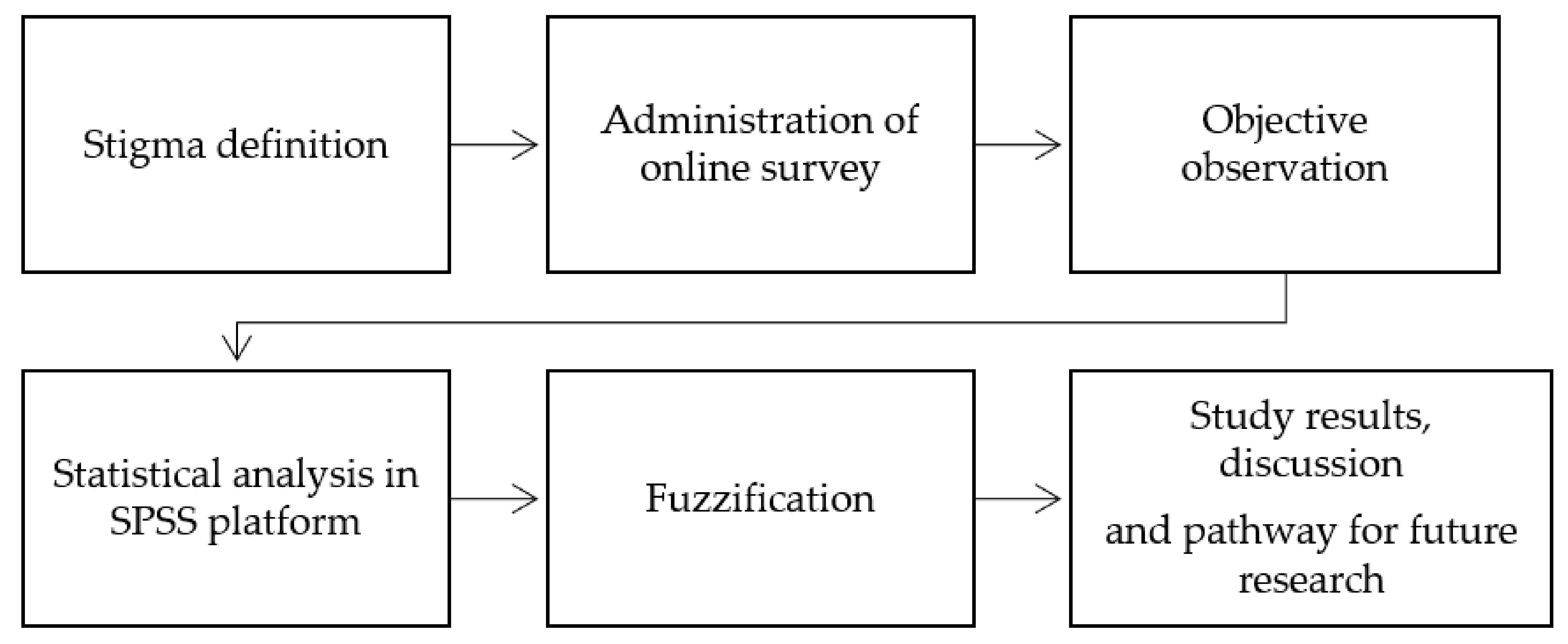

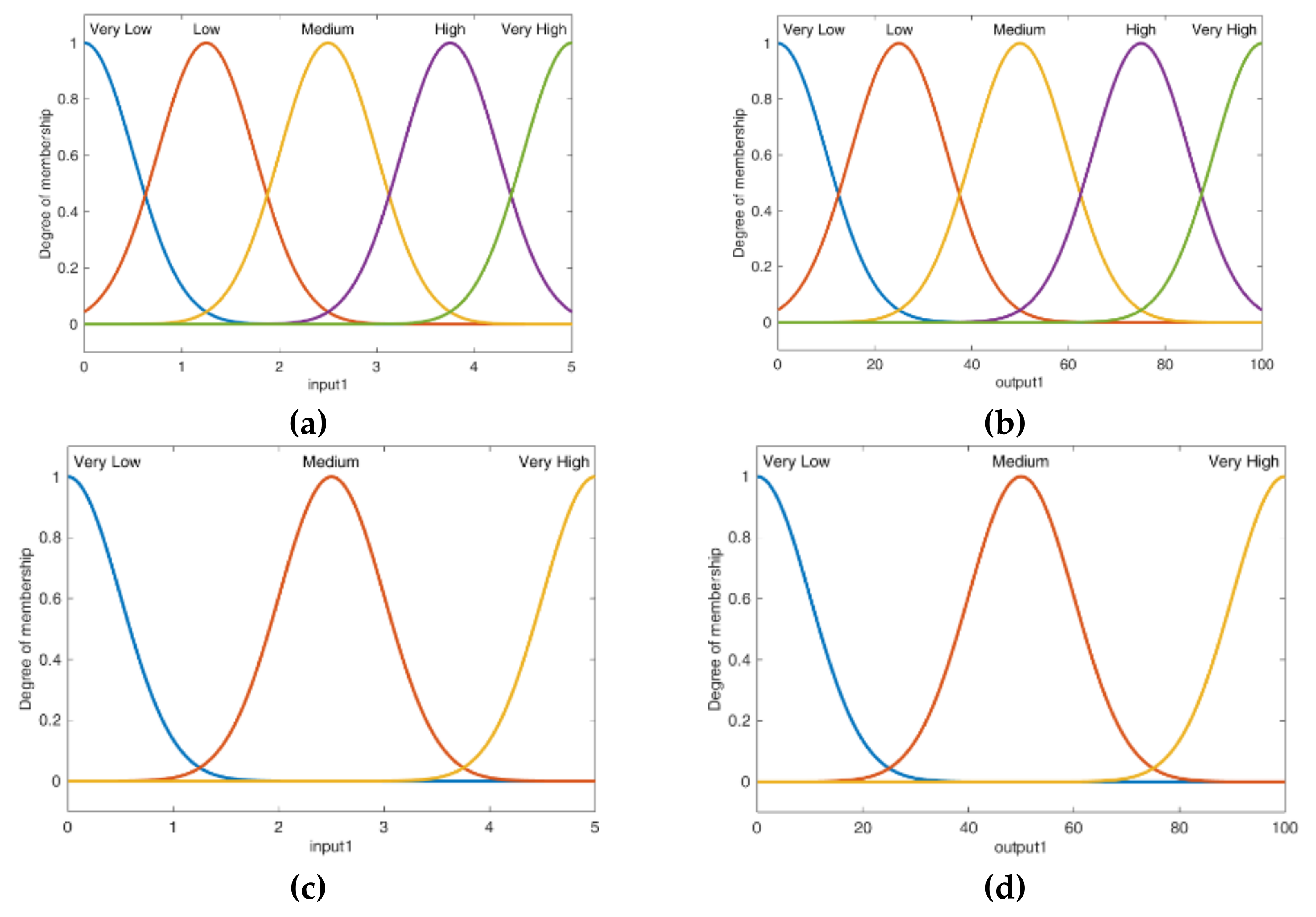


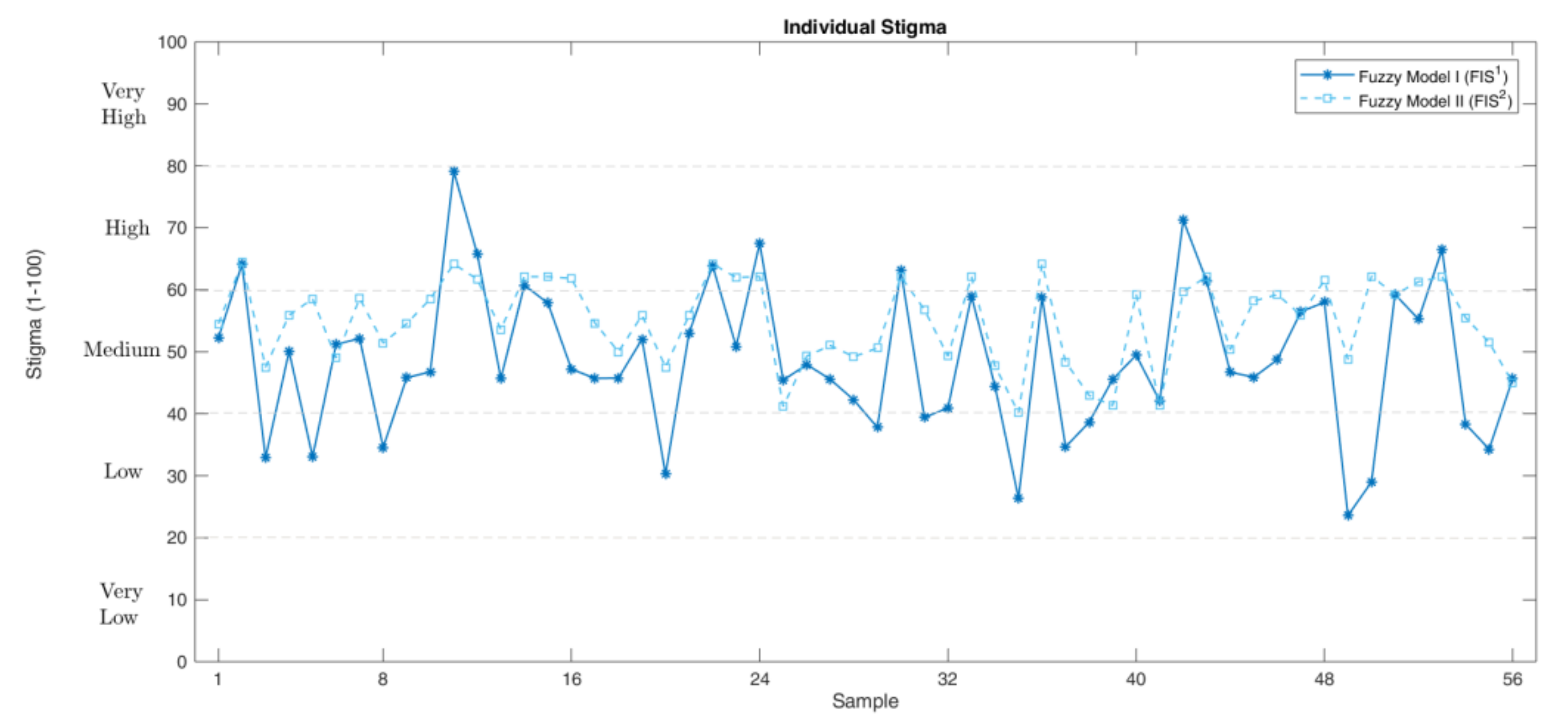
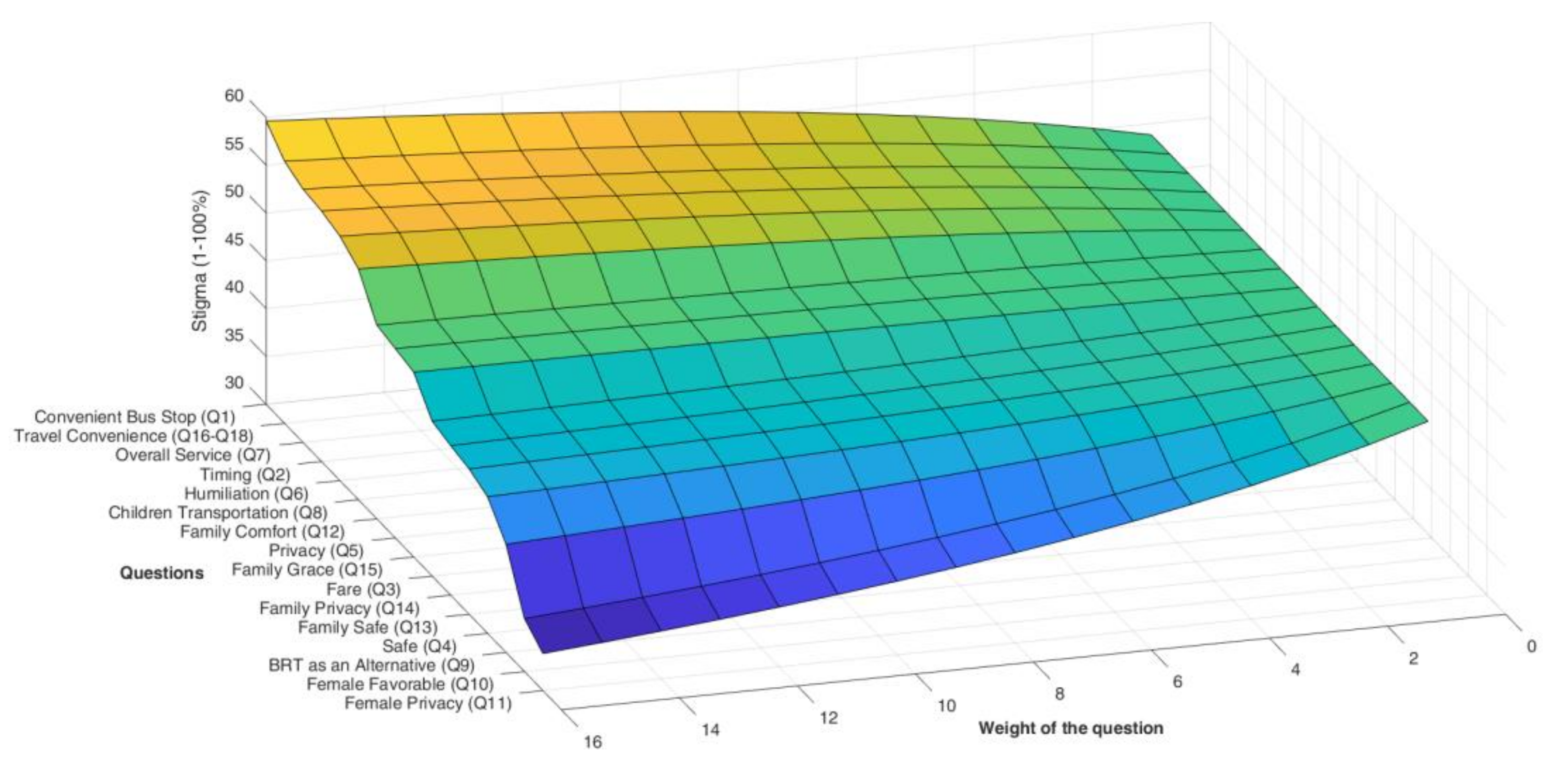

| Macro-Area | ID | Variable | Impact | Macro-Area | ID | Variable | Impact |
|---|---|---|---|---|---|---|---|
| Perception | Q1 | Convenient Bus Stop | R | Gender | Q10 | Female Favorable | D |
| Q2 | Timing | R | Q11 | Female Privacy | D | ||
| Q3 | Fare | R | Family | Q12 | Family Comfort | R | |
| Q4 | Safe | R | Q13 | Family Safe | R | ||
| Q5 | Privacy | R | Q14 | Family Privacy | R | ||
| Q6 | Humiliation | D | Q15 | Family Grace | R | ||
| Q7 | Overall Service | R | Travel Convenience | Q16 | Commute to Office | R | |
| Children | Q8 | Children Trans. | R | Q17 | Travel to Stores | R | |
| Q9 | BRT as an Alternative | R | Q18 | Visiting Leisure Venues | R |
| Inputs | |||
|---|---|---|---|
| 5 | |||
| 3 |
| FIS | MFs | Weight | Input Impact | Rule |
|---|---|---|---|---|
| 5 MFs. | 1/7 (7 Questions) | R | ||
| D | ||||
| 3 MFs | 1/8 (8 Questions) | R | ||
| D | ||||
| 5 MFs | 1/3 (3 Questions Q16–Q18) | D | ||
| 5 MFs | 1/3 (3 inputs) | D |
| Reason | Non-Users Proportion (%) |
|---|---|
| Bus unavailability | 67 |
| Buses are not frequent | 13 |
| Time-table is not clear | 20 |
| Total | 100 |
| Question Abbreviation | Correlation Analysis | Fuzzy Model | Consistency | Question Abbreviation | Correlation Analysis | Fuzzy Model | Consistency |
|---|---|---|---|---|---|---|---|
| Female Favorable (Q10) | Low | Low | Yes | Timing (Q2) | Medium | High | - |
| Family Safe (Q13) | Low | Low | Yes | Fare (Q3) | Medium | Medium | Yes |
| Family Grace (Q15) | Low | Medium | - | Privacy (Q5) | Medium | Medium | Yes |
| Humiliation (Q6) | Low | High | - | Safe (Q4) | Medium | Medium | Yes |
| Children Transportation (Q8) | Low | Low | Yes | Convenient Bus Stop (Q1) | High | High | Yes |
| Family Privacy (Q5) | Low | Low | Yes | Commute to Office (Q16) | High | High | Yes |
| Female Privacy (Q11) | Low | Low | Yes | Travel to Stores (Q17) | High | High | Yes |
| BRT as an Alternative (Q9) | Medium | Medium | Yes | Visiting Leisure Venues (Q18) | High | High | Yes |
Publisher’s Note: MDPI stays neutral with regard to jurisdictional claims in published maps and institutional affiliations. |
© 2021 by the authors. Licensee MDPI, Basel, Switzerland. This article is an open access article distributed under the terms and conditions of the Creative Commons Attribution (CC BY) license (https://creativecommons.org/licenses/by/4.0/).
Share and Cite
Nahiduzzaman, K.M.; Campisi, T.; Shotorbani, A.M.; Assi, K.; Hewage, K.; Sadiq, R. Influence of Socio-Cultural Attributes on Stigmatizing Public Transport in Saudi Arabia. Sustainability 2021, 13, 12075. https://doi.org/10.3390/su132112075
Nahiduzzaman KM, Campisi T, Shotorbani AM, Assi K, Hewage K, Sadiq R. Influence of Socio-Cultural Attributes on Stigmatizing Public Transport in Saudi Arabia. Sustainability. 2021; 13(21):12075. https://doi.org/10.3390/su132112075
Chicago/Turabian StyleNahiduzzaman, Kh Md, Tiziana Campisi, Amin Mohammadpour Shotorbani, Khaled Assi, Kasun Hewage, and Rehan Sadiq. 2021. "Influence of Socio-Cultural Attributes on Stigmatizing Public Transport in Saudi Arabia" Sustainability 13, no. 21: 12075. https://doi.org/10.3390/su132112075
APA StyleNahiduzzaman, K. M., Campisi, T., Shotorbani, A. M., Assi, K., Hewage, K., & Sadiq, R. (2021). Influence of Socio-Cultural Attributes on Stigmatizing Public Transport in Saudi Arabia. Sustainability, 13(21), 12075. https://doi.org/10.3390/su132112075











